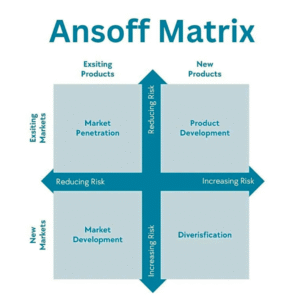What Is the Ansoff Matrix?
The Ansoff Matrix, developed by Igor Ansoff in 1957, is a strategic planning tool used by businesses to identify and evaluate growth opportunities. It provides a framework for analyzing how a company can grow through existing or new products in existing or new markets. The matrix is divided into four key growth strategies: Market Penetration, Product Development, Market Development, and Diversification.
1. Market Penetration
Market Penetration focuses on increasing sales of existing products within existing markets. This is considered the least risky strategy, as it involves leveraging what the company already knows current products and current customers.
- Goals: Increase market share, boost customer loyalty, and outperform competitors.
- Examples: Promotional campaigns, price reductions, loyalty programs, or improving product usability.
- Best suited for: Competitive markets where growth potential still exists.
2. Product Development
This strategy involves creating new products to serve existing markets. It requires significant investment in innovation, research and development, or acquiring new product capabilities.
- Goals: Meet evolving customer needs, stay ahead of competitors, and retain current customers.
- Examples: Introducing a new product line, improving existing features, or offering product upgrades.
- Best suited for: Companies with strong market presence and deep knowledge of customer preferences.
3. Market Development
Market Development means entering new markets with existing products. This could involve targeting new customer segments, expanding into new geographic regions, or using new distribution channels.
- Goals: Increase sales by reaching new audiences who haven’t yet used the product.
- Examples: Launching into a foreign market, targeting a new demographic, or exploring B2B opportunities.
- Best suited for: Companies with scalable products and the capacity to manage expansion risk.
4. Diversification
Diversification is the riskiest but potentially most rewarding strategy. It involves entering entirely new markets with new products. This approach is often pursued to reduce dependency on existing markets or in response to industry disruption.
- Goals: Spread risk, open new revenue streams, and future-proof the business.
- Examples: A fashion brand launching a tech accessory, or a food company entering health supplements.
- Best suited for: Businesses with the resources and risk tolerance to explore unfamiliar markets and offerings.
Visual Overview of the Ansoff Matrix
Here’s a simple diagram to illustrate the Ansoff Matrix:

How to Use the Ansoff Matrix in Business Strategy
The Ansoff Matrix is ideal for evaluating risk levels and aligning growth initiatives with business capabilities. Before deciding on a strategy, companies should consider internal strengths, market conditions, customer demand, and competitive dynamics. The model also works well in tandem with other strategic tools like the SWOT analysis or Porter’s Five Forces.
Real-World Example: Apple
Market Penetration: Apple regularly runs promotional campaigns for iPhones to increase existing customer retention.
Product Development: The introduction of the Apple Watch and AirPods extended their product ecosystem.
Market Development: Apple expanded its services to emerging markets like India and Brazil.
Diversification: With Apple TV+, the company entered the streaming content industry—an entirely new market.
Conclusion
The Ansoff Matrix remains one of the most powerful tools for crafting growth and innovation strategies. By helping companies balance risk and opportunity, it enables informed decision-making that aligns with both short-term goals and long-term vision. Whether you’re scaling a startup or guiding a multinational, understanding the Ansoff Matrix is essential for sustainable business growth.




